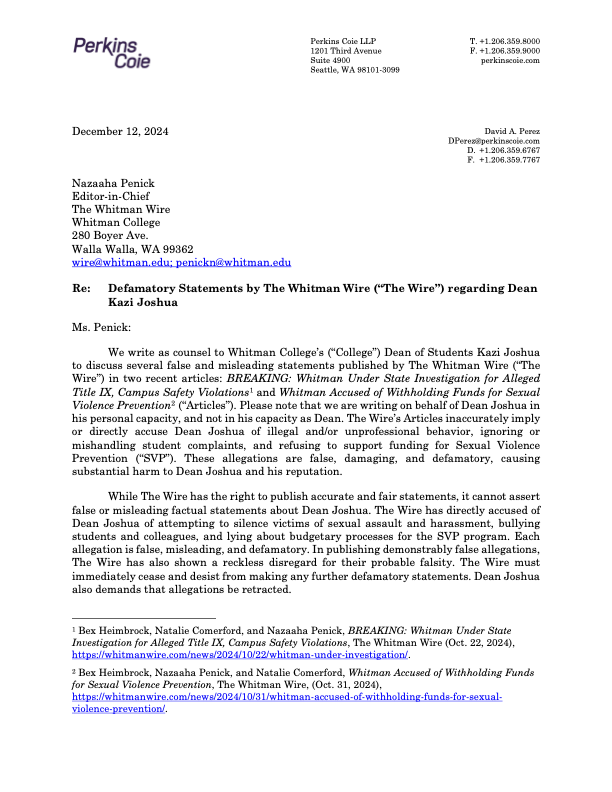The stretch of Highway 12 between Walla Walla and the Tri-Cities is a well-frequented route by Whitman students, faculty and staff and it serves as a critical transportation link for eastern Washington. Congress recently approved a historic $109 million grant from the U.S. Department of Transportation to continue expanding the highway to a four-lane corridor, across all its phases. This is one of the largest rural grants of its kind that the department has ever awarded, marking a significant milestone in a multi-decade infrastructure project.
The main purpose of the grant
Elizabeth Chamberlain, city manager of Walla Walla, described the grant as a key step in the phased expansion of Highway 12.
“There have been eight phases of this corridor expansion from the Tri-Cities to Walla Walla. This effort has been ongoing for over 20 years, and this latest phase is meant to address the last stretch that remains two-lane,” Chamberlain said.
According to Chamberlain, the primary motivation for the expansion is safety.
“The two-lane section of Highway 12 has been a concern, particularly when it comes to passing trucks and other vehicles. This creates significant safety hazards,” Chamberlain said.
By converting the road into a fully four-lane highway, officials are aiming to reduce accident risks and improve overall travel conditions for commuters and commercial vehicles alike.
Economic and developmental impacts
Beyond safety, the project is expected to become a boon for economic development in the greater Walla Walla region. The four-lane expansion will result in improved transportation infrastructure to further facilitate commerce, particularly in agriculture and industrial operations.
“The Port of Walla Walla has about 1,200 acres of industrial land in various stages of development,” Chamberlain said. “A four-lane corridor would help attract new businesses, enhance freight movement and connect the region more effectively to larger economic hubs like the Tri-Cities and Seattle.”
Economic experts echo this sentiment, supporting the idea that infrastructure investment has historically played a significant role in economic development.
“Highway development, particularly in rural areas, can generate economic activity by making transportation more accessible and efficient,” Professor Wisnu Sugiarto of Whitman College’s Economics Department said.
He added that improved road infrastructure could encourage new manufacturing firms and businesses to establish themselves along the corridor, however, this has contentions involving major or detrimental shifts in economic trends.
“While new businesses may emerge, there could also be a redistribution of existing economic activities, with some businesses relocating closer to the highway to take advantage of increased accessibility,” Sugiarto said.
This aspect of economic transition will be key to monitor as the project progresses.
Tourism and connectivity
In addition to boosting economic activity, the highway expansion is also expected to benefit Walla Walla’s tourism industry. Guy Glaeser, executive director of Visit Walla Walla, expects that decreased travel times and increased road safety will likely attract more visitors from major regional markets such as Seattle, Spokane and Portland.
“Most of our visitors drive here rather than fly, and for over 35% of our drive-market visitors, this expansion will provide a significantly improved route,” Glaeser said. “Safer and shorter travel times could encourage more people to visit Walla Walla, boosting the local economy.”
Tourism in Walla Walla is most heavily centered around its wine industry, outdoor recreation, arts and culture. According to Glaeser, the latest data indicates that while hotel occupancy in the area has remained relatively stable, retail sales in key tourism sectors such as accommodations, dining, arts and entertainment have shown promising growth.
“With improved transportation infrastructure, we anticipate a gradual increase in visitors and a stronger economic impact in these sectors,” Glaesar said.
Challenges
Despite the enthusiasm surrounding the expansion, funding challenges persist. Chamberlain pointed out that while the federal grant provides a significant portion of the project’s cost, it does not cover the entire expense.
“The full project cost is around $310 million, and we still need to secure approximately $75 million in matching funds from the state,” Chamberlain said. “Given the state’s current billion-dollar shortfall in the transportation budget, securing these funds will be an uphill battle.”
In addition to funding hurdles, the project might also result in unintended consequences. Professor Sugiarto highlighted potential negative impacts, including environmental impacts and changes to local economic dynamics.
“Expanding highways can disrupt wildlife migration patterns and increase vehicle emissions, contributing to environmental concerns,” Sugiarto said.
While improved road access may benefit certain businesses or industries, it could also divert economic activity away from smaller local hubs, concentrating development along the highway corridor while leaving traditional town centers struggling to compete. This is further extended by the fact that highway infrastructure might circle back to congestion as more and more people demand its use, defeating its initial purpose.
“If the necessary funding is secured, the Washington State Department of Transportation anticipates that the project will go out for bid in 2027, with the earliest completion date estimated to be 2030,” said Chamberlain.
Until then, local leadership and community members are expected to continue advocating for the completion of this long-anticipated infrastructure upgrade.
The Highway 12 expansion represents one of the most significant infrastructure investments in Walla Walla’s history. Whether in terms of safety, economic growth or tourism, the benefits of a four-lane corridor are clear. However, securing the necessary state funding remains a key challenge that will determine how quickly these improvements become a reality, and communities remain a key issue to be dealt with.
As the final phase of this almost two-decade-long project inches closer to completion, the eastern Washington community, eagerly anticipates the transformation that a safer and more efficient Highway 12 will bring.





Michael • Feb 21, 2025 at 5:12 pm
If this was on the rainy side the project would have been finished 15 years ago.